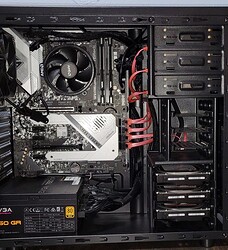It’s time to separate building a NAS from the building a PC topic. A moderator can move the relevant messages to here is they want. I’ll recap just in case.
First, why do it yourself if you can buy one?
- To learn how.
- It can be less expensive if you already have some of the components or find them at a recycler. Example: I wanted a spare case as a test bench and found a Cooler Master case with five 3.5" bays and five 5.25" bays for $20 and came with a DVD drive and a PSU. This was after I already bought the case I wanted for my NAS. If it wasn’t so massive, I’d be tempted to move everything into there.
- Not locked into a proprietary system such as QNAP, where if it fails, you have to buy another because of the way the drives are handled.
- You can decide between a small case that requires a more expensive tiny-sized motherboard and PSU and is limited on number of drives you can fit in there versus a larger case that will hold the number of drives you want and accepts less-expensive motherboards of common sizes.
- A quick look on Amazon shows that the cost of a pre-built NAS without discs jumps a lot as you add each additional drive bay. Example: 2-bay NAS ≈ $220, 4-bay NAS ≈ $360, 8-bay NAS ≈ $1000.
As a rough guide, maybe a four drive system is the cut-off point between buying pre-built and homebrew?
Why wouldn’t you do it?
- Convenience. Someone else already did the work to make it.
- Plenty of well-known companies to get them from, such as Synology, QNAP and Asustore.
- Homebrew could wind up being more expensive when you tally up what you spent on the hardware, excluding drives.
Hard drive selection:
- Hard drives are a separate cost. Pre-built units will be labeled “diskless” if they don’t include drives.
- At present, mechanical hard drives have a good price per terabyte ratio. SSD isn’t there yet but is closing the gap. It’s a toss-up right now whether NVMe will be a better alternative to SSDs in the future.
- Get NAS-rated drives. This could be your primary lifeboat for your data. Longer warranty, spins slower so they run cooler, designed for the job.
- Do not use drives made with Shingled Magnetic Recording. The extra capacity isn’t worth the performance drop due to the continual song-and-dance the drive has to go through to update recorded data.
●● With Western Digital drives, this means making sure you buy their “Red Plus” or “Red Pro” line instead of “Red”. Other brands are more straightforward in their brand names. - You might be able to get a NAS-rated drive inside an external hard drive unit like a WD MyBook for cheaper than buying the bare-bones drive itself. I couldn’t find a way of determining the type of drive WD puts in them, so I bought bare-bones drives. The good news is they arrived in one box instead of multiple shipments.


